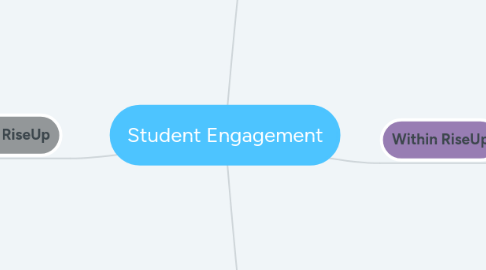
1. "Engagement first, then content, then rigor." –Kelly Gallagher
2. Within RiseUp
2.1. Academics/Instruction
2.1.1. Course Design
2.1.1.1. challenge level/differentiation
2.1.1.2. culturally relevant curriculum/content
2.1.1.3. interdisciplinary courses
2.1.1.4. instructional strategies
2.1.1.5. integrated technology
2.1.1.6. collaborative group work
2.1.1.7. Project Based course design
2.1.2. Supportive Practices
2.1.2.1. Relationship with teacher
2.1.2.2. ELD instructional supports and growth
2.1.2.3. structures to catch up
2.1.2.4. Accommodations for students in SPED
2.1.2.5. Adapt to meet learning preferences
2.1.2.6. targeted academic supports
2.1.2.7. Culturally Responsive Practices
2.1.2.8. assistive technology
2.1.2.9. Flexible deadlines
2.1.2.10. Proactive support meetings
2.1.3. Assessment
2.1.3.1. PBL/authentic products
2.1.3.2. Student choice in assessment product
2.1.3.3. Student exhibitons
2.1.3.4. Competency based assessment
2.2. SEL/Student Support
2.2.1. Counseling
2.2.2. Community Gathering
2.2.3. Individualized Learning Plans
2.2.4. Advisory
2.2.5. Check-ins
2.2.6. MTSS
2.2.7. Restorative Practices
2.2.8. Basic needs
2.2.9. Addictions support
2.3. Culture, Community & Relationships
2.3.1. sense of belonging
2.3.2. positive adult relationship(s)
2.3.3. positive peer relationship(s)
2.3.4. Weekly Gathering
2.3.5. Sports
2.3.6. Exhibitions
2.3.7. Extracurriculars like Prom
3. Factors Outside of RiseUp
3.1. Supportive People
3.2. Family
3.3. Basic Needs
3.3.1. food assistance
3.3.1.1. school-based food bank
3.3.1.2. weekly food delivery during remote
3.3.2. housing assistance
3.3.2.1. emergency
3.3.2.2. long term
3.3.3. healthcare
3.3.3.1. dental
3.3.3.2. optical
3.3.3.3. primary care
3.3.3.4. mental health
3.3.3.5. addiction counseling
3.3.4. Utilities
3.3.5. Access to Wifi
3.4. Navigating Systems
3.4.1. Court
3.4.2. Police
3.4.3. Gov. programs
3.5. Employment
3.6. Transportation/Commute
3.7. Childcare
4. 1. Attendance
4.1. 2. Relationships & Sense of Belonging
4.1.1. 3. Engagement
4.1.1.1. 4. Student Learning/Academic Achievement
